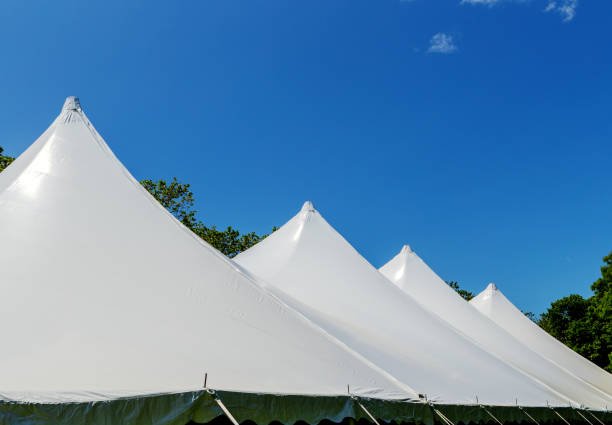Canopy tents provide versatile, economical shelter for a wide range of outdoor activities and events. With their simple set-up and expansive covered space, canopy tents offer durable protection from the elements for everything from backyard gatherings to farmers’ markets to construction sites. This comprehensive guide covers everything you need to know about canopy tents.
What is a Canopy Tent?
A canopy tent refers to a portable open-air tent structure that consists of a roof and supporting legs. Key features include:
- Roof made of water-resistant fabric like polyester or vinyl
- Supported by a lightweight metal frame and adjustable legs
- Provides shade and overhead shelter without enclosed walls
- Used for temporary or semi-permanent shelter
- Available in a range of sizes from 10 x 10 ft. up to 30 x 60 ft.
- Transportable and easy to set up and take down
With their versatile utility, canopy tents are useful in diverse settings from backyards to worksites to large events.
Benefits of Canopy Tents
Canopy tents offer many advantages that make them useful across countless applications:
- Quick, easy set-up within minutes
- Provides instant overhead shelter from sun, rain, and wind
- More airflow than enclosed tents
- Temporary structure doesn’t require permitting
- Available in a wide range of sizes to suit needs
- Highly portable and compact when disassembled
- Inexpensive compared to other structures
- Durable and reusable over many years
- Ideal shelter for markets, picnics, gatherings, and more
Canopy tents balance practicality, versatility, and affordability.
Common Uses of Canopy Tents
Canopy tents can serve many functions thanks to their simplicity and spaciousness:
- Outdoor events – Craft fairs, festivals, trade shows, weddings
- Backyard gatherings – BBQs, graduations, family reunions
- Camping – Mess tents, cabin shelters, cooking areas
- Sports tournaments – Team tents, spectators, concessions
- Worksites – Equipment and worker shelter, temporary office space
- Farmers markets – Vendor booths, product displays
- Park shelters – Picnic areas, rest spaces
- Vehicle protection – Cars, boats, ATVs, construction equipment
Wherever you need quick overhead cover, canopy tents deliver.

Types of Canopy Tents
There are a few main canopy tent varieties:
Pop-Up Canopies
- Spring-loaded frame pops open
- No assembly required
- Sizes from 10 x 10 ft. to 15 x 15 ft.
Frame Canopies
- The roof attaches to the sliding measured frame
- More size options up to 30 x 60 ft.
- Commercial grade durability
High Peak Canopies
- Taller sloped roof around 10-14 ft. high
- Grand appearance; optimal headroom
Expansion Canopies
- Modular design links multiple units
- Flexibly increase/decrease footprint
Consider factors like portability, cost, and planned use to select an ideal canopy.

Key Parts of a Canopy Tent
- Cover fabric – Water-repellent roof made of polyester, vinyl, canvas
- Frame – Adjustable powder-coated steel poles hold up the roof
- Legs – Height-adjustable aluminum or steel legs add stability
- Anchor points – Loop straps or rings attach the cover to the frame
- Corner joints – Hinged or clamped joints connect the frame
- Wheeled carry bag – For transportation when disassembled
- Stakes, ropes – Guy lines and stakes secure in the wind
- Accessory hooks – For attaching sidewalls, lights, etc.
Look for quality materials and sturdy hardware for longevity.
What Size Canopy Tent Do I Need?
Consider how much head space and floor area you require:
- Small 10 x 10 ft: 64 sq ft area, 7-9 ft height
- Medium 15 x 15 ft: 225 sq ft area, 8-10 ft height
- Large 20 x 20 ft: 400 sq ft area, 9-11 ft height
- Extra Large 30 x 60 ft: 1800 sq ft area, 11-14 ft height
Measure your furniture/setup to visualize spacing. Factor in some extra margin. Height is based on leg extension.

How to Choose the Best Canopy Tent
Keep these factors in mind when selecting a canopy tent:
- Intended use – Casual vs. commercial grade; permanent vs. temporary shelter
- Size/footprint – Ensure adequate headroom and space for your needs
- Portability – Weight, carry case, and transportability required
- Durability – Frame strength; UV-resistant and waterproof cover
- Setup/takedown ease – Prefer quicker and simpler solo assembly
- Optional sidewalls – Provide connectable leg walls for privacy or wind protection
- Anchoring – Ratchet rope/strap tie-downs or weighted feet
- Warranty – Look for 1-2+ years against defects; longer is better
- Cost – Set a budget; prices range from $100-$2000+
Select the optimal balance of quality and affordability.
How to Set Up a Canopy Tent
Follow these tips for safe, effective canopy tent assembly:
- Clear areas of branches, rocks, and other debris
- Unpack the tent and identify all pieces; assemble the frame
- Extend legs to desired height; lock braces at corners
- Raise frame and set on legs once extended
- Drape cover over top and hook to anchor points
- Attach canopy sidewalls or tie-downs if needed
- Check frame is square and canopy taught with no sags
- Stake down anchored feet or use weights for wind resistance
- Add accessories like lighting, racks, and shelving as desired
Setup is quick and straightforward in just a few steps.
Securing Canopy Tents in Wind
Wind is the biggest hazard for canopy tents. Follow these guidelines to keep canopy tents secure:
- Select a sheltered area or orient tent to avoid wind broadside
- Use ratchet straps or high-weight anchoring foot systems
- Stake down leg feet with heavy-duty stakes
- Install canopy sidewalls to reduce wind underneath
- Add robust internal ropes/cables across roof trusses
- Monitor weather; disassemble in severe wind storms
- Avoid extended use in high-wind zones
- Remove banners, and signage when unattended
Proper anchoring is crucial to prevent damage, especially with larger canopies.
Maintenance Tips for Canopy Tents
- Inspect frame joints, corners, and roof for damage before/after use
- Clean fabric tops with a soft brush and mild soap if needed
- Let dry fully before packing away; check for mildew
- Replace broken frame elements; keep spare parts on hand
- Lubricate sliding parts with silicone spray if sticky
- Re-coat fabric annually with waterproofing treatments
- Store folded in a carry bag out of weather and sunlight
Well-maintained canopies will deliver many years of service.
Common Canopy Tent FAQs
Q: How much weight can a canopy tent handle?
A: Load capacity varies by model, but most can handle 100-500 lbs across the roof if weight is evenly distributed. Check manufacturer specs.
Q: Can you leave canopy tents up permanently?
A: Canopies are designed for temporary use. For permanent shelter, consider installing a permanent awning or pergola instead.
Q: What is the best canopy tent fabric?
A: Polyester is preferred for its strength, UV resistance and water repellency. Vinyl coated polyester adds more weatherproofing. Avoid cotton or canvas.
Q: Do I need a permit for a canopy tent?
A: Usually not for temporary personal use. But check local codes for size thresholds, commercial use, etc. that may require permits.
Q: How do you anchor a canopy tent on concrete?
A: Use weighted feet designed to grip concrete, or tie tension lines to heavy objects like water barrels instead of stakes.
Q: What size canopy tent do I need for 50 people?
A: For 50 mingling guests, look for a 20 x 40 ft or 30 x 30 ft canopy. Bigger is better to avoid crowding.
Q: Can you heat a canopy tent?
A: Yes, you can use portable patio heaters or commercial-grade tent heaters safely under a canopy with caution. Ensure adequate ventilation.
Q: How much wind can a canopy tent withstand?
A: Most can handle 10-20 mph winds if properly secured. Heavier commercial models may withstand up to 40 mph winds.
Key Takeaways
- Canopy tents offer versatile, economical overhead shelters with quick setups.
- Sizes range from compact pop-ups to expansive event canopies.
- Choose portable or commercial grade based on intended functions.
- Anchor securely, especially in windy conditions.
- Maintain waterproofing and frame integrity over time.
- Great for vendors, shade, events, storage, camping, and more!
My Final Thoughts
Canopy tents provide customizable covered space to suit almost any need thanks to their practical design, ease of use, and modular expandability. They can shelter small backyard gatherings just as readily as busy multi-day fairs or festivals. Use this guide’s tips to select the ideal canopy tent size, features, and anchoring system to deliver durable service for any upcoming activities on your calendar.
Pair your canopy with sidewalls, weights, or tie-downs to keep it securely in place no matter the weather. With a quality canopy tent on hand, you’ll always be ready to create instant sheltered space anytime it’s needed.


